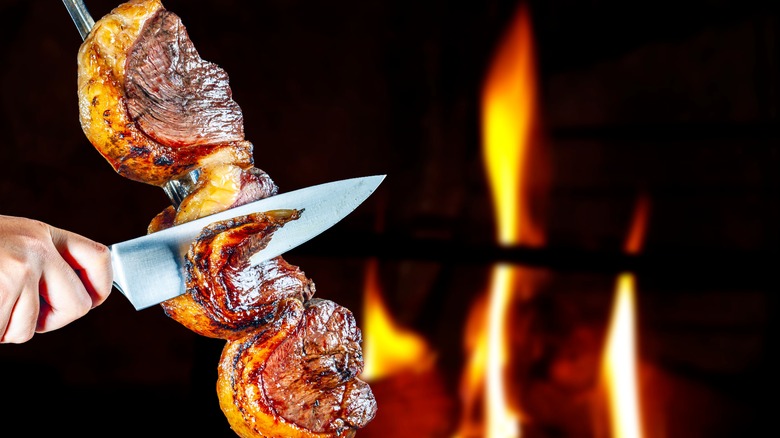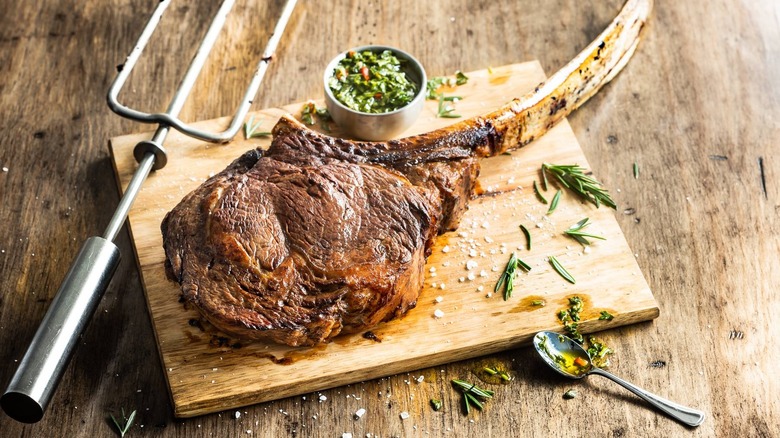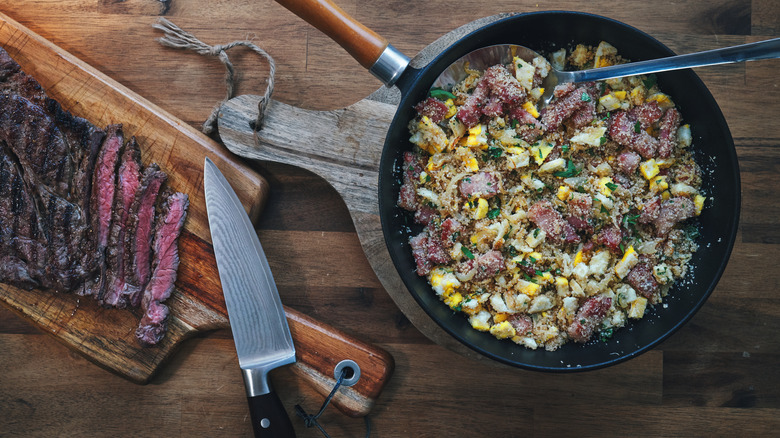The Secret Tactic To Sample The Most Meat At A Brazilian Steakhouse
Restaurant chains like Rodizio Grill and Fogo de Chão introduced Americans to Brazilian steakhouse dining in the 1990s, and the concept has been growing in popularity ever since. The reason is pretty simple. Other than vegans and vegetarians, of course, who doesn't love the idea of all-you-can-eat meat? Especially when it's brought to your table on skewers and sliced right onto your plate.
Brazilian steakhouses introduced Americans to an entirely new vocabulary, from churrasco-style barbecued meats — most notably, the succulent picanha cut — to rodizio-style tableside service, with green and red cards to signal diners' degree of readiness for additional courses. These steakhouses also introduced a more tactical approach to dining. Some churrascaria veterans, for example, will eschew bread, salads, certain side dishes, or even dessert to ensure they have enough belly room to sample all the abundant meat varieties.
One favored tactic to get the most out of a Brazilian steakhouse visit involves some practical course management. Given that these restaurants typically serve well over a dozen different meat options, a bit of pacing is necessary for those who want to extract the maximum value for the prix fixe price. The best practice, then, is to leave the green card up for the first five meat courses, then alternate between red and green for subsequent meat varieties. This tactic spaces out courses, meaning you'll be able to enjoy even more delicious meat before inevitably becoming satiated.
A tactical approach to the churrascaria experience
Churrascaria is the Brazilian word for this type of steakhouse, and although there are now a wide variety of restaurants of this type open across the United States, most adhere to a similar formula. For instance, rarely is there a formal menu. Diners pay a prix fixe price, which entitles them to all the available foods they can eat. Meat is the star, of course, but plenty of other options are also available, from salads and side dishes to decadent desserts.
Given that the prices for these all-you-can-eat feasts are not cheap, most value-conscious diners understand that many of the offerings are a trap. They are dishes the restaurant owners want you to fill up on because they cost little to make. Even among the meat varieties, there are very definite drop-offs in value, from picanha and filet mignon to pork ribs and bacon-wrapped chicken. So the savvy diner will want to ensure they can enjoy the prime meat cuts — some of which may be served near the end of the meal — by avoiding, or at least portion controlling, some of the preliminary fare.
Taking a tactical approach to the meat varieties is also important. For example, the first five, then the alternating approach we advocated for, is great in theory. But if one of the alternating courses you were expecting to take a pass on turns out to be filet mignon or tomahawk ribeye, then adjust the schedule accordingly.
More tips and tricks to enhance the Brazilian steakhouse experience
Managing the salad bar is one of the keys to optimizing your dining experience at a Brazilian steakhouse. Yes, the skewers of meat are the main attractions. But you also want to enjoy a well-rounded meal, which means you must choose wisely from among vegetables, salads, and sides. Some traditional Brazilian side dishes — farofa, for example, a toasted yucca dish; or feijoada, a meaty black bean stew over rice — are absolutely delicious. However, if the goal is to maximize consumption of prime steak cuts, you may want to skip the more filling options in favor of a Caesar salad or a simple selection of veggies.
A practical approach must also be taken with seafood. Brazilian-style steakhouses like Fogo de Chão, Rodizio Grill, and Texas de Brazil all typically offer seafood dishes, albeit primarily as appetizers. There's no doubting the quality of these options, but that still doesn't mean you should fill up on shrimp cocktail or smoked salmon. Save your appetite for steak.
By all means, order a couple of caipirinhas, a signature Brazilian cocktail, to accompany dinner. Dessert is often omitted entirely by churrasco aficionados, but if you still have an appetite after green carding samples from a dozen or more meaty skewers, then go ahead and cap off your meal in style. You've obviously earned it based on savvy tactical awareness and sound course management.



